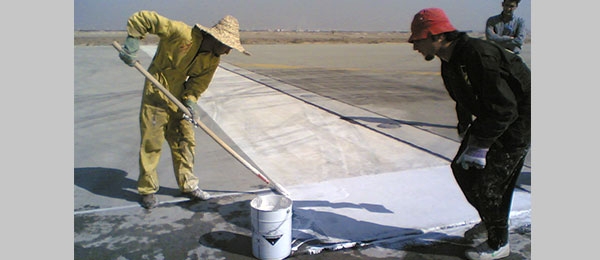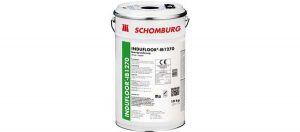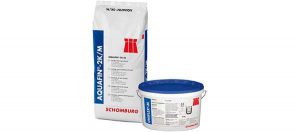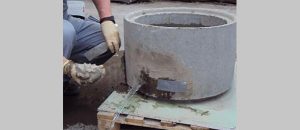ASODUR®-SG2 INDUFLOOR®-IB1240 Art.-No. 2 05655 Special primer / Oil and vapour barrier
• Two component, low solvent, moisture tolerant epoxy resin.
•Water vapour impermeable.
•Due to its high density, ASODUR-SG2 displaces the water from the surface capillaries of concrete substrates and acts as a barrier to oil rising through capillary action.
• Forms a very good bond to damp concrete substrates.
• Prevents penetration of radon.
Areas of application:
•As a special priming treatment for oil contaminated but previously cleaned concrete substrates.
•As effective protection against the formation of osmosis bubbles when there is moisture penetrating from the rear.
•As a capillary breaking grout to the pool edge with high level water tables, up to 1:1 filled with 0.1– ۰.۶ mm quartz sand.
•As a priming treatment for concrete/bonded screeds that are still damp, which are to receive floor coverings such as PVC, linoleum, carpet, parquet, tiles etc. Please refer to the advice section.
•As a primer for SOLOPLAN-30-PLUS.
Technical Data:
Basis: two component epoxy resin
Colour: light grey
Viscosity*: approx. 70 s in a 4 mm DIN standard cup
Mixture ratio: 100:12 parts by weight
Density*: 1.86 g/cm3 Ambient and substrate
temperature: min. +10 °C max. +35 °C at max. 80% rel. humidity
Pot life: approx. 60 minutes at +23 °C approx. 30 minutes at +30 °C
Foot traffic after*: approx. 12 hrs
Overcoat after*: approx. 12 hrs (when broadcast with quartz sand)
Fully cured after*: approx. 7 days
Compressive strength: approx. 80 N/mm2
Flexural strength: approx. 30 N/mm2 Tensile adhesion
strength: B 1.5 Water vapour
permeability: SD > 50 m (Class III according to EN 1504-2) * at +23 °C and 50% rel. humidity.
Cleaning tools: Clean tools immediately after use with ASO-R001.
Packaging: 2 kg, 5 kg, 15 kg and 28 kg containers. Components A and B are delivered at a predetermined mix ratio.
Storage: frost free, cool and dry, 24 month in the original unopened containers, ≥ +۱۰ °C to +25 °C. Use opened containers promptly.
Substrate preparation
The areas to be treated must be:
•Dry or damp (in accordance with DAfStB RiLi SIB*), solid, load-bearing and have a good key.
• Free from separating and adhesion reducing substances such as e.g. dust, laitance, grease, rubber marks, paint residues and similar. Furthermore, ASODUR-SG2 can also be used on the following substrates:
•Concrete and cement-based screed areas subjected to reverse moisture penetration
•Concrete and cement-based screed areas with increased residual moisture* *) “Guidelines for the protection and repair of concrete sections”, part 2, section 2.3.5 “Concrete moisture”, ۰۷.۲۰۰۲.Prepare substrates with reference to DIN EN 14879-1:2005, 4.2 following. Dependent on the condition of the substrate to be treated, use suitable mechanical preparation methods, e.g. high pressure water blasting, scabbling, shot blasting, planing etc, with which a textured, open surface is achieved. (Repair voids and cracks beforehand with a suitable product from the SCHOMBURG range).
Oil contaminated concrete:
• Following the preparation of the substrate, treat the affected area with the cleaning agent ASO-R008 (diluted in accordance with the technical data sheet for
ASO-R008).
•Clean the treated area with warm water (approx. +50°C to +70°C).
•Remove excess water with a suitable vacuum.
•Apply ASODUR-SG2 immediately to the surface whilst it is still damp, working in with a brush and finishing evenly with a paint roller.
Please note: No completely closed water film must be present on the surface of the concrete. The substrate may not dry out – with drying there is a risk that the oil will rise again and thus no bond will be achieved between the special primer and the substrate. Appropriate to each particular substrate, the following criteria are also to be fulfilled:
Concrete quality: min. C20/25
Screed quality: min. EN 13813 CT-C25-F6
Tensile adhesion strength: > 1.5 N/mm2
Product preparation:
Component A and component B are delivered at a predetermined mixing ratio. Tip component B into component A. Ensure that the hardener drains completely from its container. Mix both components with a suitable mixer at 300 rpm. It is important to ensure that the hardener is evenly dispersed. Stir until the mix is homogenous (free from streaks); mixing time approx. 3 minutes. The minimum temperature during mixing should be around +15° C. Do not use mixed material directly from the packaging. Decant the mixed material into a clean container and mix through thoroughly once again.
Application method/consumption: Using a rubber squeegee, apply ASODUR-SG2 to saturation onto the cleaned, matt damp substrate and thoroughly work into the surface with a priming brush and back roll with a short nap paint roller. Blind the fresh primer with quartz sand (grain size: 0.5 – ۱.۰ mm diameter). Once hardened, carefully remove all nonbound quartz sand before subsequent coatings are applied to the primer. Material consumption: Dependent on the substrate, the consumption is between 600 to 1000 g/m2. Consumption of broadcast sand approx. 1500 g/m2. After waiting for approx. 12–۲۴ hours any ASODUR coating system can be applied, beginning with the primer belonging to the system or alternatively other floor finishes can be applied. Capillary breaking
fluid grout: When using ASODUR-SG2 as a capillary grout, fill the ASODUR-SG2 with 0.1–۰.۶ mm quartz sand at a mixingratio of 1:1 parts by weight.
Mix density: approx. 2.15 g/cm³
Consumption: approx. 2,150 g/Liter Broadcast the surface of the resin, before it hardens, with 0.5–۱.۰ mm quartz sand.
Important advice:
•When using organic acids (e.g. propanoic acid), or if they are present in drive-in silo plants, ASODUR-SG2 may not be used as the only waterproofing and surface protection measure. ASODUR-SG2 is to be coated with a top coat material appropriate to the service conditions.
•When using ASODUR-SG2 as a vapour barrier beneath conventional floor coverings e.g. PVC, linoleum, carpet and parquet, do not use solvent based adhesives. This will lead to bulging in the floor finish installed.
•Use ASODUR-SG2-thix for vertical surfaces.
•As a rule, SCHOMBURG products are supplied in working packs i.e. at a mix ratio matched together. When supplied in large containers, part quantities must be weighed out using a balance. Always thoroughly stir the filled components and only then mix with the second component. This is to be executed with a suitable stirrer e.g. Polyplan/Ronden mixing paddle or similar. In order to exclude mixing errors, decant into a clean container and mix anew. The mixing speed should be approx. 300 rpm. Ensure that no air is mixed in. The temperature of the components should be minimum +15°C. This is also valid for any potential fillers to be mixed, e.g. sands. The addition of the fillers is only to occur once both liquid components have been blended. Afterwards place the completely mixed material immediately on to the prepared substrate and quickly and carefully spread out in accordance with the instructions in the technical data sheet. For applications by roller, it is recommended to use a short nap nylon paint roller (6 mm) with a textured polyamide cover or similar. Always thoroughly stir one component products before use.
•Higher temperatures shorten the pot life. Lower temperatures increase the pot life and setting time. Material consumption is also increased at lower
temperatures.
•Colours: Small variations in colour, resulting from varying production batches and raw material fluctuations, are unavoidable. When applying coatings, take this into consideration. Carry out neighbouring sections with the same production batch (same batch number on the packaging).
• The bond between individual coats can be heavily impeded by the penetration of moisture and contamination between the individual coats. Coating work requires a substrate temperature of at least 3°C above the dew point temperature.
• If there is a long down time between individual coats or if already treated areas are to be renewed with liquid resins after a long period of time, then the old surface is to be well cleaned and thoroughly abraded. Afterwards carry out a completely new pinhole free coating.
•Surface protection systems must be protected from moisture (e.g. rain, melt water) after their application for approx. 4–۶ hours. Moisture produces a white discolouration and/or stickiness on the surface and can lead to interference in the curing process. Take off discoloured and/or sticky surfaces by e.g. planing or abrasive blast techniques and renew.
•Consumption quantities given are values determined by calculation without additions for surface roughness or absorption, levelling or residues in the containers. We recommend adding a calculated safety factor of 10% to the computed consumption quantities.
•Applications, which are not clearly mentioned in this technical data sheet may only be implemented after consultation with and written confirmation from the technical service department of SCHOMBURG.
•Cured product residues can be disposed of using waste disposal code AVV 150106. Please observe a valid EU safety data sheet.
GISCODE: RE 2




